Types of Wolfs

Tundra wolves have a territory covering over 1,000 square miles, according to the International Wolf Center. This is because prey is scarce. Tundra wolves are carnivorous. The largest animal they target is the musk oxen, followed by the caribou. Smaller prey includes snow goose, ptarmigan, small rodents and arctic hare.

The Alexander Archipelago wolf (Canis lupus ligoni), also known as the Islands wolf, is a subspecies of the gray wolf, Canis lupus. The coastal wolves of southeast Alaska inhabit the area that includes the Alexander Archipelago, its islands, and a narrow strip of rugged coastline that is biologically isolated from the rest of North America by the Coast Mountains.
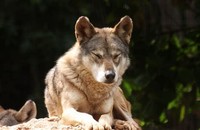
The Arabian wolf is a subspecies of gray wolf which lives on the Arabian peninsula. It is the smallest sized wolf known. It is a desert-adapted wolf that normally lives in small groups and is omnivorous, eating carrion and garbage as well as small to medium-sized prey.

The Arctic wolf (Canis lupus arctos), also known as the white wolf or polar wolf, is a subspecies of gray wolf native to the Queen Elizabeth Islands, from Melville Island to Ellesmere Island.

The Baffin Island wolf (Canis lupus manningi), also known as the Baffin Island tundra wolf, is a subspecies of gray wolf which resides exclusively on Baffin Island and several nearby islands. It was not formally recognized as a subspecies until 1943, when it was given its taxonomic classification by Anderson.

Bernard's wolf (Canis lupus bernardi), also known as the Banks Island tundra wolf, Banks Island wolf, and the Victoria's Island wolf, is an extinct subspecies of the gray wolf that was limited to the Banks and Victoria Island of the Canadian arctic.

The British Columbia wolf (Canis lupus columbianus) is a subspecies of gray wolf which lives in a narrow region that includes those parts of the mainland coast and near-shore islands that are covered with temperate rainforest, which extends from Vancouver Island, British Columbia, to the Alexander Archipelago in south-east Alaska.
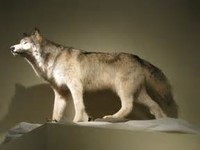
The thirty-eight subspecies of Canis lupus are listed in Mammal Species of the World (third edition) that was published in 2005, and in the Catalogue of Life. The nominate subspecies is the Eurasian wolf (Canis lupus lupus), also known as the common wolf.

The Cascade mountain wolf (Canis lupus fuscus) is an extinct subspecies of the gray wolf that was once found in British Columbia, Oregon, and Washington. The wolf became extinct in 1940. It was originally identified as a separate species by Richardson in 1839 and from other wolves in the area by Edward Goldman in 1945.

Dingo is a coordinate term of wolf. As nouns the difference between dingo and wolf is that dingo is (taxlink), a wild dog native to australia while wolf is a large wild canid of certain subspecies of canis lupus .

Dogs and wolves are actually the same species. Their physical appearance is similar but their instincts, disposition and temperament are widely different. The gray wolf, or simply the wolf is the largest wild member of the Canidae family.

The Eurasian Wolf (Canis lupus lupus), also known as the Common Wolf, European Wolf, Carpathian Wolf, Steppes Wolf, Tibetan Wolf and Chinese Wolf is a subspecies of the Grey Wolf (Canis lupus). Currently, it has the largest range among wolf subspecies and is the most common in Europe and Asia, ranging through Western Europe, Scandinavia, Russia, China, Mongolia and the Himalayan Mountains.

The Florida black wolf (Canis lupus floridanus), also known as the Florida wolf and the black wolf, is an extinct subspecies of Canis lupus that lived in Florida. This subspecies became extinct in 1908 due to crowding out of its habitat and hunting.

The Great Plains wolf (Canis lupus nubilus), also known as the buffalo wolf or loafer, is an extinct subspecies of gray wolf with a distribution that once extended throughout the Great Plains from southern Manitoba and Saskatchewan southward to northern Texas.
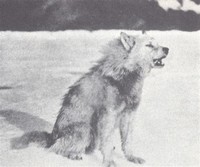
The Greenland wolf is a subspecies of gray wolf that is native to Greenland. More than 90% of the wolf's range falls within the boundaries of the Northeast Greenland National Park, where the wolf population was estimated in 1998 to be 55 wolves due to a lack of prey.

Gregory's wolf (Canis rufus gregoryi), also known as Gregory's red wolf, the Mississippi Valley wolf, and sometimes as the Texas red wolf and the swamp wolf is a subspecies of the red wolf, Canis rufus, that in its original range roamed the regions in and around the lower Mississippi River basin, and now inhabits North Carolina, US.

The Ezō wolf, or Hokkaidō wolf (Canis lupus hattai Kishida, 1931) is an extinct subspecies of the gray wolf (Canis lupus). In 1890, the skulls of Japanese wolves (Canis lupus hodophilax) were compared with those of wolves from Hokkaido in the British Museum.

The Hudson Bay wolf (Canis lupus hudsonicus) is a subspecies of gray wolf native to northern Keewatin, including the northwestern coast of Hudson Bay in Canada.

The Iberian wolf (Canis lupus signatus) is a subspecies of grey wolf that inhabits the forest and plains of northern Portugal and northwestern Spain. The 2003 census estimated the total Iberian population to be 2,000 wolves.
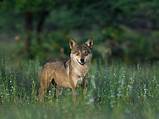
For the Indian Wolf a diet that is composed of small animals is what they survive on. This includes rodents, rabbits, and raccoons. The pack will be very loosely around a given area and each of them will hunt for their own food.

The Italian wolf (Canis lupus italicus), also known as the Apennine wolf, is a subspecies of grey wolf native to the Italian Peninsula. It inhabits the Apennine Mountains and the Western Alps, though it is undergoing expansion towards the north and east. As of 2005, the Italian wolf population is estimated to consist of 500 individuals.

The Japanese wolf, or Honshū wolf, (Canis lupus hodophilax Temminck, 1893) is a subspecies of the gray wolf (Canis lupus). Skeletal remains of the Japanese wolf have been found in archaeological sites, such as Torihama shell mound, dating from the Jōmon period (10,000 to 250 B.C).

The Kenai Peninsula wolf (Canis lupus alces), also known as the Kenai Peninsula grey wolf, is an extinct subspecies of the gray wolf that lived on the Kenai Peninsula in southern Alaska. History. The species was classified in 1941 as one of the four subspecies in Alaska by Edward Alphonso Goldman.
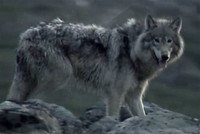
The Labrador wolf (Canis lupus labradorius) is a subspecies of gray wolf native to Labrador and northern Quebec. It has been described as ranging in color from dark, grizzly gray to almost white, and of being closely related to C. l. beothucus.

The Mackenzie River wolf (Canis lupus mackenzii) is a subspecies of gray wolf which is found in the Canadian Northwest Territories. Not much has been "published" on Canis lupus mackenzii but one of the most comprehensive studies was done in 1954 by W.A. Fuller, Wolf Control Operations, Southern Mackenzie District, Canada Wildlife Service Report.

The Manitoba wolf (Canis lupus griseoalbus), also known as the grey-white wolf, is an extinct subspecies of gray wolf that roamed in southern Northwest Territories, northern Alberta, Saskatchewan, and south-central Manitoba.
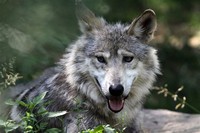
The Mexican wolf (Canis lupus baileyi), also known as the lobo, is a subspecies of gray wolf once native to southeastern Arizona, southern New Mexico, western Texas and northern Mexico.

Wolves seldom bark, except in alarm; dogs are natural barkers. Dogs and wolves howl, but dogs may add yips to the howl. Both dogs and wolves can be territorial, but wolves are likely to kill interlopers as competition or food. Like dogs, wolves dig and can be terribly destructive if left to their own devices.

The Mogollon mountain wolf (Canis lupus mogollonensis) is an extinct subspecies of gray wolf whose range once included southern and western Texas and northeastern Mexico. It is darker than its more northern cousins, and has a highly arched frontal bone.
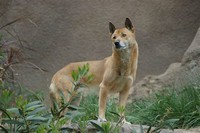
The New Guinea singing dog or New Guinea Highland dog (Canis lupus dingo or Canis familiaris) is a type of rare dog native to the New Guinea Highlands of the island of New Guinea. Its taxonomic status is debated. The dog is noted for its unique vocalization. Some experts have referred to it as a wild dog, but others disagree.

The Newfoundland wolf (Canis lupus beothucus) is an extinct subspecies of gray wolf native to Newfoundland. It was described as being a medium-sized, slender-skulled wolf with a white pelt, though melanists also occurred.

The northern Rocky Mountain wolf (Canis lupus irremotus) is a subspecies of gray wolf native to the northern Rocky Mountains. It is a light-colored, medium to large-sized subspecies with a narrow, flattened frontal bone.

The northwestern wolf (Canis lupus occidentalis), also known as the Mackenzie Valley wolf, Alaskan timber wolf, Canadian timber wolf, or northern timber wolf, is a subspecies of gray wolf in western North America.

The steppe wolf (Canis lupus campestris), also known as Caspian Sea wolf, is a subspecies of grey wolf native to the Caspian steppes, the steppe regions of the Caucasus, the lower Volga region, southern Kazakhstan north to the middle of the Emba, the northern Urals, and the steppe regions of the lower European part of the former Soviet Union.

The Gray Wolf is a close relative of domestic dogs. Its thick fur ranges in color from creamy white, reddish-brown, to shades of gray and black. Gray wolves are the largest species of wolf and range between 50 - 90 pounds and 4 - 5 feet long. Adult males are larger than adult females. Life History Gray wolves breed once a year.
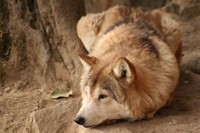
The Tibetan wolf (Canis lupus filchneri) is a subspecies of the gray wolf that is native to China in the regions of Gansu, Qinghai, and the Tibetan Plateau. It is found in northern India in the Ladakh region of eastern Kashmir, and the Lahaul and Spiti region in the northeastern part of Himachal Pradesh.

The Tundra Wolf (Canis lupus albus) is a subspecies of Grey Wolf that can be found throughout northern Europe and Asia, primarily in the northern arctic and boreal regions of Russia. Although Tundra Wolves were eliminated from some of the Arctic islands north of Siberia, they have been recently seen on Wrangle Island.

The Vancouver Island wolf (Canis lupus crassodon) is a subspecies of grey wolf, endemic to Vancouver Island, British Columbia, Canada. It is very social with other wolves, and lives in packs of about five to thirty-five. It is very shy, and is rarely seen by humans.

The North American wolf Canis lupus pambasileus is a subspecies of gray wolf that is called the Yukon wolf in Canada and the Alaskan Interior wolf in the United States. It is native to the Alaska Interior and Yukon, save for the tundra region of the Arctic Coast.